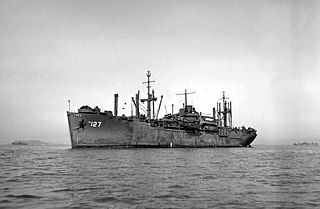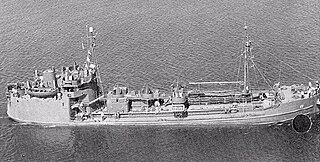
USS Starr (AKA-67) was a Tolland-class attack cargo ship in service with the United States Navy from 1944 to 1946. She was sold into commercial service and scrapped in 1970.

USS Ancon (AGC-4) was one of three identical ships built for the Panama Railroad Company put into operation in 1938. The ship was converted to a troop ship by the Army in January 1942, making several voyages to Australia with troops as an Army Transport. In August 1942 the ship's operation was transferred to the United States Navy for the duration of World War II and converted to a combined headquarters and communications command ship.

USS Alchiba (AKA-6) was an Arcturus-class attack cargo ship of the United States Navy, named after Alchiba, a star in the constellation Corvus. She served as a commissioned ship for 4 years and 7 months.

USS Allendale (APA-127) was a Haskell-class attack transport in service with the United States Navy from 1944 to 1946. She was scrapped in 1988.

USS Anne Arundel (AP-76) was an American transport ship that was built in 1940 and scrapped in 1970. Originally laid down as the Mormacyork, she was later named after Anne Arundel County, Maryland. Annapolis is the county seat there, the state capital, and also the home of the Naval Academy. Anne Arundel earned five battle stars for her World War II service.
USS Yahara (AOG-37) was a Mettawee-class gasoline tanker acquired by the U.S. Navy for the dangerous task of transporting gasoline to warships in the fleet, and to remote Navy stations.

USS Wabash (AOG-4) was a Patapsco-class gasoline tanker acquired by the U.S. Navy for the dangerous task of transporting gasoline to warships in the fleet, and to remote Navy stations.

USS Enoree (AO-69) was a Chiwawa-class oiler constructed for the United States Navy during World War II. She was the only U.S. Navy ship named for the Enoree River in South Carolina.

USS Auriga (AK-98) was an Auriga-class cargo ship, the only ship in her class, commissioned by the U.S. Navy for service in World War II, named after the constellation Auriga. She was responsible for delivering troops, goods and equipment to locations in the war zone.

USS Adria (AF-30) was an Adria-class stores ship in service with the United States Navy from 1944 to 1954. She was scrapped in 1977.

USS Agawam (AOG-6) was a Patapsco-class gasoline tanker acquired by the U.S. Navy for the dangerous task of transporting gasoline to warships in the fleet, and to remote Navy stations.

USS Mettawee (AOG-17) was a Mettawee-class T1 tanker type gasoline tanker acquired by the U.S. Navy for the dangerous task of transporting gasoline to warships in the fleet, and to remote Navy stations.
USS Pasquotank (AOG-18) was a Mettawee-class T1 tanker type gasoline tanker acquired by the U.S. Navy for the dangerous task of transporting gasoline to warships in the fleet, and to remote Navy stations.
USS Seekonk (AOG-20) was a Mettawee-class gasoline tanker acquired by the U.S. Navy for the dangerous task of transporting gasoline to warships in the fleet, and to remote Navy stations.
USS Sequatchie (AOG-21) was a Mettawee-class gasoline tanker acquired by the U.S. Navy for the dangerous task of transporting gasoline to warships in the fleet, and to remote Navy stations.
USS Wautauga (AOG-22) was a Mettawee-class gasoline tanker of the United States Navy during World War II.
USS Hiwassee (AOG-29) was a Mettawee-class gasoline tanker acquired by the U.S. Navy for the dangerous task of transporting gasoline to warships in the fleet, and to remote Navy stations.
USS Towaliga (AOG-42) was a Mettawee-class gasoline tanker acquired by the U.S. Navy for the dangerous task of transporting gasoline to warships in the fleet, and to remote Navy stations.

USS Chehalis (AOG-48) was a Patapsco-class gasoline tanker acquired by the United States Navy for the dangerous task of transporting gasoline to warships in the fleet, and to remote Navy stations. The vessel was named after the Chehalis River located in Washington state.

USS LST-779 was a United States Navy LST-542-class tank landing ship used in the Asiatic-Pacific Theater during World War II.












